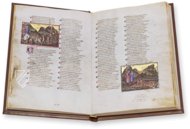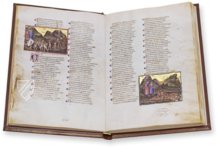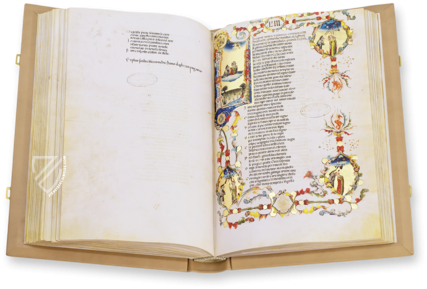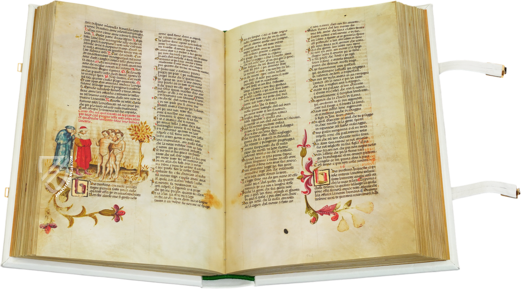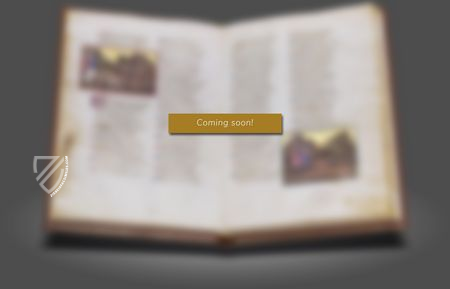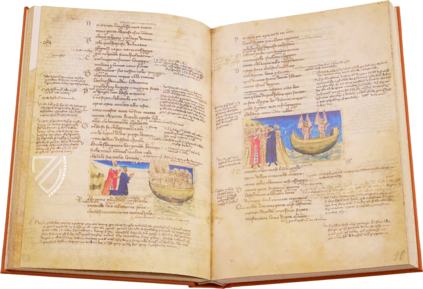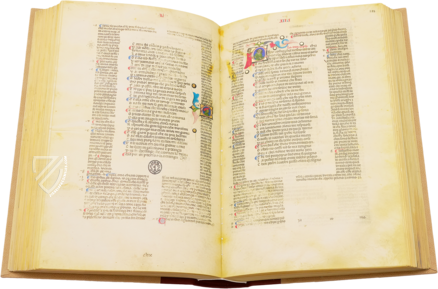Dante Alighieri - Divine Comedy - Angelica Manuscript
(3,000€ - 7,000€)
This outstanding manuscript of Dante’s Divina Commedia originated from Bologna during the Trecento. Illustrated with 34 impressive and groundbreaking miniatures, the codex contains two commentaries on the literary milestone in addition to the text itself and a fragment of a work by Gualterus de Castellione. In this way, the Divine Comedy from the Biblioteca Angelica in Rome, also known as the Roman Codex, offers a comprehensive inside view of this primary work of world literature and its reception both artistically and literarily.
Dante Alighieri - Divine Comedy - Angelica Manuscript
Dante Alighieri (1265–1321) became one of the most important authors of world literature with his primary work, the Divine Comedy. Originating in the early Trecento and completed in the year 1321, the Divine Comedy is one of the most important works of world literature with exceptional significance for Italian literary history. The tale, in the course of which the author himself travels through hell, purgatory, and paradise, enjoyed an extensive reception and has influenced men of letters, artists, and other creative types up to today.
An Incomplete Masterpiece
The 34 miniatures, which adorn the manuscript from the Biblioteca Angelica in Rome, make this a true jewel of art history. A master of illumination from Bologna – the names Simone dei Crocefissi, Oderisi da Gubbio, and Franco Bolognese have been discussed in the field of research – created the illustrated artwork, which accompanies the tale of the Inferno. Since the codex has remained incomplete, many places where miniatures were supposed to have been inserted later, remain white in the text of Purgatory and Paradise. Nonetheless, the 34 scenes presented are completely sufficient to land the codex an outstanding place in the history of Dante illustrations.
Elegant Exemplary Compositions
Rectangular narrow red frames surround these gorgeous miniatures on a gold background. These are integrated respectively into one of the two columns in which the text is arranged. Only the opening scene is depicted in a broader miniature. Elegant compositions accompany each section of the Inferno, synoptically illustrating the content and presenting the figures and episodes of the story. Furthermore, blue and red initials adorn the text, sometimes designed with the finest ornamentation. Therefore, the manuscript represents an outstanding example of Bolognese illumination in the Trecento. The high quality and creative décor of the manuscript shaped some significant iconographic standards of Dante illustration.
Dante’s Work and its Immediate Reception
Alongside this inestimable artistic content, the literary content of the manuscript should not be underestimated. Aside from Dante’s Divina Commedia, the codex also contains the commentaries by Jacopo Alighieri and Bosone da Gubbio with the title Capitolo Sulla Commedia, in addition to a fragment of the poem by Gualterus de Castellione about Alexander the Great. Thus, the codex is simultaneously a demonstration of the grandiose interest that Dante’s work enjoyed shortly after its creation.
Codicology
- Alternative Titles
- Divina Commedia Angelica
Göttliche Komödie - Rom Codex
Dante Alighieri - Divine Comedy from the Biblioteca Angelica in Rome - Size / Format
- 208 pages / 34.7 × 23.7 cm
- Origin
- Italy
- Date
- 2nd half of the 14th century
- Epochs
- Style
- Genre
- Script
- Gothic Textura
- Illustrations
- 34 large miniatures
- Content
- Dante Alighieri’s Divine Comedy along with Jacopo Alighieri’s and Bosone da Gubbio’s commentaries entitled Capitolo sulla Commedia, and a fragment of the poem on the history of Alexander the Great written by Gualterus de Castellione.
- Artist / School
- Simone dei Crocefissi
Probably Oderisi da Gubbio and Franco Bolognese
Workshop of Mezzaratta di Bologna
Dante Alighieri - Divine Comedy - Angelica Manuscript
Canto XIV
Each of the three books of the Divine Comedy is divided into 33 so-called cantos and in this manuscript containing the Inferno, each canto is preceded by a miniature. After arriving at the walled City of Dis, which contains the sixth through ninth circles of Hell, they encounter heretics and then those guilty of violence. Those who have committed acts against God, Art, and Nature are doomed to eternity on a great Plain of Burning Sand where it continuously rains flakes of fire.

Dante Alighieri - Divine Comedy - Angelica Manuscript
Dante Meets Virgil
The great magnum opus begins on the night before Good Friday in the year 1300 with the author/protagonist lost in a dark wood and being pursued by a lion, a leopard, and a she-wolf. The forest represents sin and each of the three beasts represents a different kind of sin: the self-indulgent, the violent, and the malicious. Hell is later divided according to these classifications.
Dante, dressed in pink with a blue hat and sleeves, is rescued by the esteemed ancient Roman author Virgil, who stands confidently on the right wearing a red cap and blue cloak trimmed in fur with a red tunic on underneath. Virgil then accompanies Dante on his journey to the underworld. The scene is illuminated by a wonderful gold leaf background.

- Treatises / Secular Books
- Apocalypses / Beatus
- Astronomy / Astrology
- Bestiaries
- Bibles / Gospels
- Chronicles / History / Law
- Geography / Maps
- Saints' Lives
- Islam / Oriental
- Judaism / Hebrew
- Single Leaf Collections
- Leonardo da Vinci
- Literature / Poetry
- Liturgical Manuscripts
- Medicine / Botany / Alchemy
- Music
- Mythology / Prophecies
- Psalters
- Other Religious Books
- Games / Hunting
- Private Devotion Books
- Other Genres
- Afghanistan
- Armenia
- Austria
- Belgium
- Colombia
- Croatia
- Cyprus
- Czech Republic
- Denmark
- Egypt
- Ethiopia
- France
- Germany
- Greece
- Hungary
- India
- Iran
- Iraq
- Israel
- Italy
- Japan
- Lebanon
- Luxembourg
- Mexico
- Morocco
- Netherlands
- Palestine
- Peru
- Poland
- Portugal
- Russia
- Serbia
- Spain
- Sri Lanka
- Sweden
- Switzerland
- Syria
- Turkey
- Ukraine
- United Kingdom
- United States
- Uzbekistan
- Aboca Museum
- Ajuntament de Valencia
- Akademie Verlag
- Akademische Druck- u. Verlagsanstalt (ADEVA)
- Aldo Ausilio Editore - Bottega d’Erasmo
- Alecto Historical Editions
- Alkuin Verlag
- Almqvist & Wiksell
- Amilcare Pizzi
- Andreas & Andreas Verlagsbuchhandlung
- Archa 90
- Archiv Verlag
- Archivi Edizioni
- Arnold Verlag
- ARS
- Ars Magna
- ArtCodex
- AyN Ediciones
- Azimuth Editions
- Badenia Verlag
- Bärenreiter-Verlag
- Belser Verlag
- Belser Verlag / WK Wertkontor
- Benziger Verlag
- Bernardinum Wydawnictwo
- BiblioGemma
- Biblioteca Apostolica Vaticana (Vaticanstadt, Vaticanstadt)
- Bibliotheca Palatina Faksimile Verlag
- Bibliotheca Rara
- Boydell & Brewer
- Bramante Edizioni
- Bredius Genootschap
- Brepols Publishers
- British Library
- C. Weckesser
- Caixa Catalunya
- Canesi
- CAPSA, Ars Scriptoria
- Caratzas Brothers, Publishers
- Carus Verlag
- Casamassima Libri
- Chavane Verlag
- Christian Brandstätter Verlag
- Circulo Cientifico
- Club Bibliófilo Versol
- Club du Livre
- CM Editores
- Collegium Graphicum
- Collezione Apocrifa Da Vinci
- Comissão Nacional para as Comemorações dos Descobrimentos Portugueses
- Coron Verlag
- Corvina
- CTHS
- D. S. Brewer
- Damon
- De Agostini/UTET
- De Nederlandsche Boekhandel
- De Schutter
- Deuschle & Stemmle
- Deutscher Verlag für Kunstwissenschaft
- DIAMM
- Droz
- E. Schreiber Graphische Kunstanstalten
- Ediciones Boreal
- Ediciones Grial
- Ediclube
- Edições Inapa
- Edilan
- Editalia
- Edition Deuschle
- Edition Georg Popp
- Edition Leipzig
- Edition Libri Illustri
- Editiones Reales Sitios S. L.
- Éditions de l'Oiseau Lyre
- Editions Medicina Rara
- Editorial Casariego
- Editorial Mintzoa
- Editrice Antenore
- Editrice Velar
- Edizioni Edison
- Egeria, S.L.
- Eikon Editores
- Electa
- Emery Walker Limited
- Enciclopèdia Catalana
- Eos-Verlag
- Ephesus Publishing
- Ernst Battenberg
- Eugrammia Press
- Extraordinary Editions
- Fackelverlag
- Facsimila Art & Edition
- Facsimile Editions Ltd.
- Facsimilia Art & Edition Ebert KG
- Faksimile Verlag
- Feuermann Verlag
- Folger Shakespeare Library
- Franco Cosimo Panini Editore
- Friedrich Wittig Verlag
- Fundación Hullera Vasco-Leonesa
- G. Braziller
- Gabriele Mazzotta Editore
- Gebr. Mann Verlag
- Gesellschaft für graphische Industrie
- Getty Research Institute
- Giovanni Domenico de Rossi
- Giunti Editore
- Graffiti
- Grafica European Center of Fine Arts
- Guido Pressler
- Guillermo Blazquez
- Gustav Kiepenheuer
- H. N. Abrams
- Harrassowitz
- Helikon
- Hendrickson Publishers
- Henning Oppermann
- Herder Verlag
- Hes & De Graaf Publishers
- Hoepli
- Holbein-Verlag
- Hortus Deliciarum
- Houghton Library
- Hugo Schmidt Verlag
- Idion Verlag
- Il Bulino, edizioni d'arte
- ILte
- Imago
- Insel Verlag
- Instituto Nacional de Antropología e Historia
- Istituto dell'Enciclopedia Italiana - Treccani
- Istituto Ellenico di Studi Bizantini e Postbizantini
- Istituto Geografico De Agostini
- Istituto Poligrafico e Zecca dello Stato
- Italarte Art Establishments
- J. Thorbecke
- Jan Thorbecke Verlag
- Johnson Reprint Corporation
- Josef Stocker
- Josef Stocker-Schmid
- Jugoslavija
- Karl W. Hiersemann
- Kasper Straube
- Kaydeda Ediciones
- Kindler Verlag / Coron Verlag
- Kodansha International Ltd.
- Konrad Kölbl Verlag
- Kurt Wolff Verlag
- La Liberia dello Stato
- La Linea Editrice
- La Meta Editore
- Lambert Schneider
- Landeskreditbank Baden-Württemberg
- Leo S. Olschki
- Les Incunables
- Library of Congress
- Libreria Musicale Italiana
- Lichtdruck
- Lito Immagine Editore
- Lumen Artis
- Lund Humphries
- M. Moleiro Editor
- Maison des Sciences de l'homme et de la société de Poitiers
- Manuscriptum
- Martinus Nijhoff
- Maruzen-Yushodo Co. Ltd.
- MASA
- McGraw-Hill
- Militos
- Millennium Liber
- Müller & Schindler
- Nahar and Steimatzky
- National Library of Wales
- Neri Pozza
- Nova Charta
- Oceanum Verlag
- Odeon
- Orbis Mediaevalis
- Orbis Pictus
- Österreichische Staatsdruckerei
- Oxford University Press
- Pageant Books
- Parzellers Buchverlag
- Patrimonio Ediciones
- Pattloch Verlag
- PIAF
- Pieper Verlag
- Plon-Nourrit et cie
- Prestel Verlag
- Princeton University Press
- Prisma Verlag
- Priuli & Verlucca, editori
- Pro Sport Verlag
- Propyläen Verlag
- Pytheas Books
- Quaternio Verlag Luzern
- Reales Sitios
- Recht-Verlag
- Reichert Verlag
- Reichsdruckerei
- Riehn & Reusch
- Roberto Vattori Editore
- Rosenkilde and Bagger
- Roxburghe Club
- Salerno Editrice
- Sarajevo Svjetlost
- Schöck ArtPrint Kft.
- Scolar Press
- Scrinium
- Scripta Maneant
- Scriptorium
- Siloé, arte y bibliofilia
- SISMEL - Edizioni del Galluzzo
- Sociedad Mexicana de Antropología
- Société des Bibliophiles & Iconophiles de Belgique
- Soncin Publishing
- Sorli Ediciones
- Stainer and Bell
- Studer
- Styria Verlag
- Sumptibus Pragopress
- Szegedi Tudomànyegyetem
- Taberna Libraria
- Tarshish Books
- Taschen
- Tempus Libri
- Testimonio Compañía Editorial
- Thames and Hudson
- The Clear Vue Publishing Partnership Limited
- The Facsimile Codex
- The Folio Society
- The Marquess of Normanby
- The Richard III and Yorkist History Trust
- Tip.Le.Co
- TouchArt
- TREC Publishing House
- TRI Publishing Co.
- Trident Editore
- Typis Regiae Officinae Polygraphicae
- Union Verlag Berlin
- Universidad de Granada
- University of California Press
- University of Chicago Press
- Urs Graf
- Vallecchi
- Van Wijnen
- VCH, Acta Humaniora
- VDI Verlag
- VEB Deutscher Verlag für Musik
- Verlag Anton Pustet / Andreas Verlag
- Verlag Bibliophile Drucke Josef Stocker
- Verlag der Münchner Drucke
- Verlag für Regionalgeschichte
- Verlag Styria
- Vicent Garcia Editores
- W. Turnowsky
- Waanders Printers
- Wiener Mechitharisten-Congregation (Wien, Österreich)
- Wissenschaftliche Buchgesellschaft
- Wydawnictwo Dolnoslaskie
- Xuntanza Editorial
- Zakład Narodowy
- Zollikofer AG




